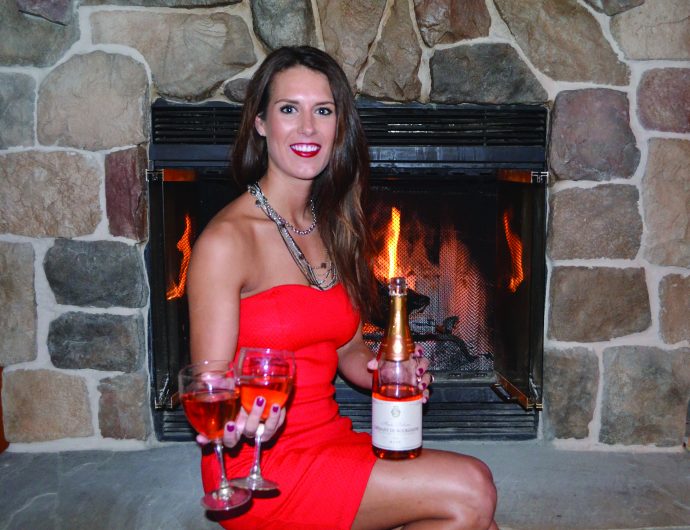February. Valentine’s Day. Recognizing your lover with some extra attention, some gifts and some romance for a day. It seems woefully inadequate that in the course of a year, a mere 24 hours is given to honoring what should be our most precious gift. Indeed, a month is given each for glaucoma awareness in January and for condom awareness in February. Weeks have been awarded for healthy weight awareness in January and for root canal awareness in March. But for our chosen life partner, confidante and lover, a mere 24 hours of recognition is the accepted norm. It comes as no surprise that people in successful relationships share many avocations, hobbies and dreams. I want to challenge you to make this Valentine’s Day memorable by upping your game, extending the celebration to a month and enhancing your wine awareness collaboratively with your special one.
My first serious wine-learning experience was a 20-session, five-month sommelier training course offered by the Sommelier Society of America. It cost more than I wanted to spend but in retrospect, it was probably the best $900 I ever spent. I have friends who have committed to 100 consecutive days of working out and others who commit to a three-day, 270-mile bike ride fundraiser. What if you and your special one committed to a monthlong pursuit of wine knowledge expansion in a do-it-yourself format? It need not be consecutive days,= as life in Westchester and Fairfield counties often requires other obligations. But for 30 days, open up a different bottle, savor it, discuss it, improve your palate and descriptive vocabulary and enjoy each other.
Start by downloading an aroma wheel (winearomawheel.com). An aroma wheel has concentric circles with radial divisions. Near the center are broad wine descriptives, and as you move toward the perimeter you will find more finely tuned adjectives to describe a wine. I’ve heard people say, “Why is this important? Can’t I just enjoy it”? If you can describe flavors that appeal to you, it makes it much easier for a sommelier or a wine store representative to steer you toward your desires.
Now download vivino.com into your smartphone. Open the vivino.com app and snap a photo of a wine label and it will tell you virtually everything you might want to know about a wine, from tasting notes, growing conditions, winemaker’s style and number of bottles produced. It will also keep a record of the wines you have enjoyed and where to find them. Many wine bottles today come with a QR code on the back that will give you all this information as well. And some wine consortia, such as Franciacorta and Chianti Classico, provide labels with serial numbers for their member wineries. You can go to their website, key in the unique number and retrieve all this information as well.
Two books that everyone interested in improving their wine awareness must own are Kevin Zraly’s “Windows on the World Complete Wine Course” and Mark Oldman’s “Brave New World of Wine.” Zraly’s book is an excellent, comprehensive step-by-step course that will guide you, complete with question-and-answer sections. And Oldman’s book attempts to break people out of old and dull wine choice habits. The books guide readers by asking what they have enjoyed in the past. With this information, lots of suggestions are offered, many from far-flung, lesser-known regions and often at a fraction of the cost.
And now for the wine. I would begin this affair with something playful, festive and bubbly. Look for bubblies that are made in the méthode champenoise or traditional method, as is done in the Champagne region, with the secondary fermentation occurring in the bottle, requiring much more skill and labor. These wines and their bubbles are far better than those made by the bulk tank-made charmat method, such as Prosecco. Try some sparklers from different places and don’t overlook a good sparkling Rosé. Obviously, Champagne must be on the list. Try a Franciacorta from Italy, a Cava from Spain and maybe a Gloria Ferrer (a great value) bubbly from California. I prefer regular white wine glasses over flutes for sparkling wine, which allows them to open up quickly and to express their flavor profile. The bottle should be opened very carefully and never with a pop. The opening sound should be no more audible than a gentle, whispery “pfffft.”
Rosés might have to be explored later as the weather warms. I prefer these wines on a boat or on a beach. These wines can also be festive, with colors ranging from salmon to bright, translucent red with fruit-driven flavors that should be delicious on a summer day. Try a few. They are typically inexpensive. The Navarra region, in northern Spain, makes Rosés tasting of strawberries, cranberries and/or raspberries. Simply lovely.
Next move on to lighter whites from around the world. Albariño, Vermentino, Sauvignon Blanc and Grüner Veltliner are all wonderful lighter wines worthy of exploration. Chardonnay oaked and unoaked, Gewürztraminer, Pinot Gris and Riesling could make up the next flight. Rieslings can show so many different flavor profiles that it is important to try several to fine-tune your preferences.
Lighter reds would be next in the progression. Check out Pinot Noir, Gamay from Beaujolais Crus, some Sangiovese and some less expensive Bordeaux blends. Heartier and robust reds are easy to find ranging from Cabernet Sauvignon, Syrah, Zinfandel, Merlot and aged Pinot Noir from Burgundy.
The final grouping is likely to be the most expensive, the most unusual and the most fun. Often known as dessert wines they can be savored at other times. These are not the sweet wines of the 1960s and ’70s, such as Blue Nun and Liebfraumilch, which did much to tarnish the German wine industry in general and Riesling wines in particular, by offering up a saccharine, awful wine. These new dessert wines are wonderful, with many flavor profiles.
Essentially, flavors are concentrated in any number of ways to make a sweet wine. Grapes from the Sauternes region in Bordeaux are attacked by the botrytis fungus. Ice wines from Canada and Germany and other countries are made from frozen grapes on the vine, which fractures the grape skin spilling some of the liquid and intensifying flavors. Amarones and Reciotos from Italy are picked and sun- or air-dried prior to pressing also to concentrate flavors. Vin Santo from Italy and Greece are barrel-aged for many years. Barrel-aging evaporation concentrates the flavor. All these wines are delicious and are usually quite costly.
So ladies and gentlemen, there is your challenge. Embrace the concept of taking this wine adventure together. Obviously it’s not necessary to finish each bottle. Some of them could be recorked for later or used for cooking. Taste some wine together analytically, enjoy a meal, share some evening entertainment, touch each other, hold each other, caress each other. Wine will bring you together.
Contact Doug Paulding at Doug@dougpaulding.com.


